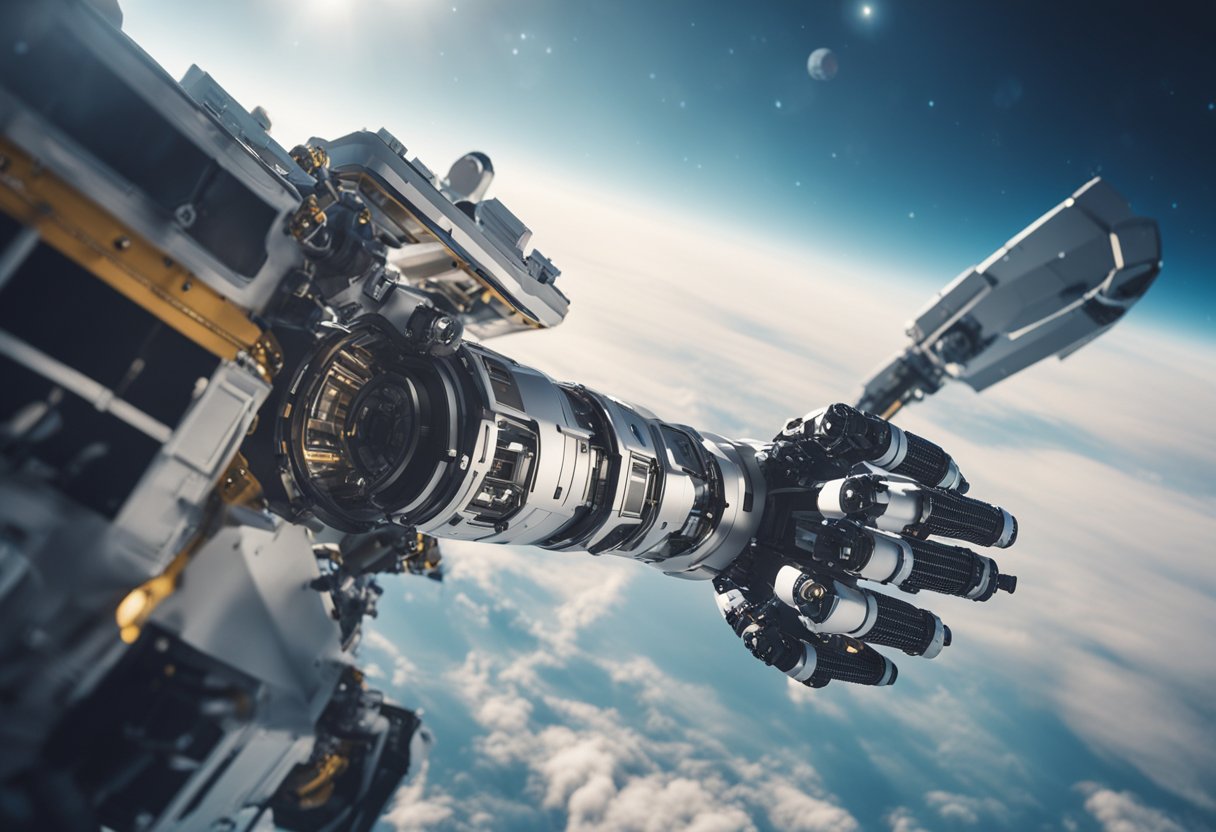
Robotic arms have revolutionised the way we conduct operations in space, serving as an extension of human capability beyond the confines of our atmosphere. These ingenious pieces of technology are critical components on satellites and space stations, performing tasks ranging from simple assembly to complex repair and maintenance. They are uniquely designed to operate in the harsh environment of space, where precision and reliability are paramount.
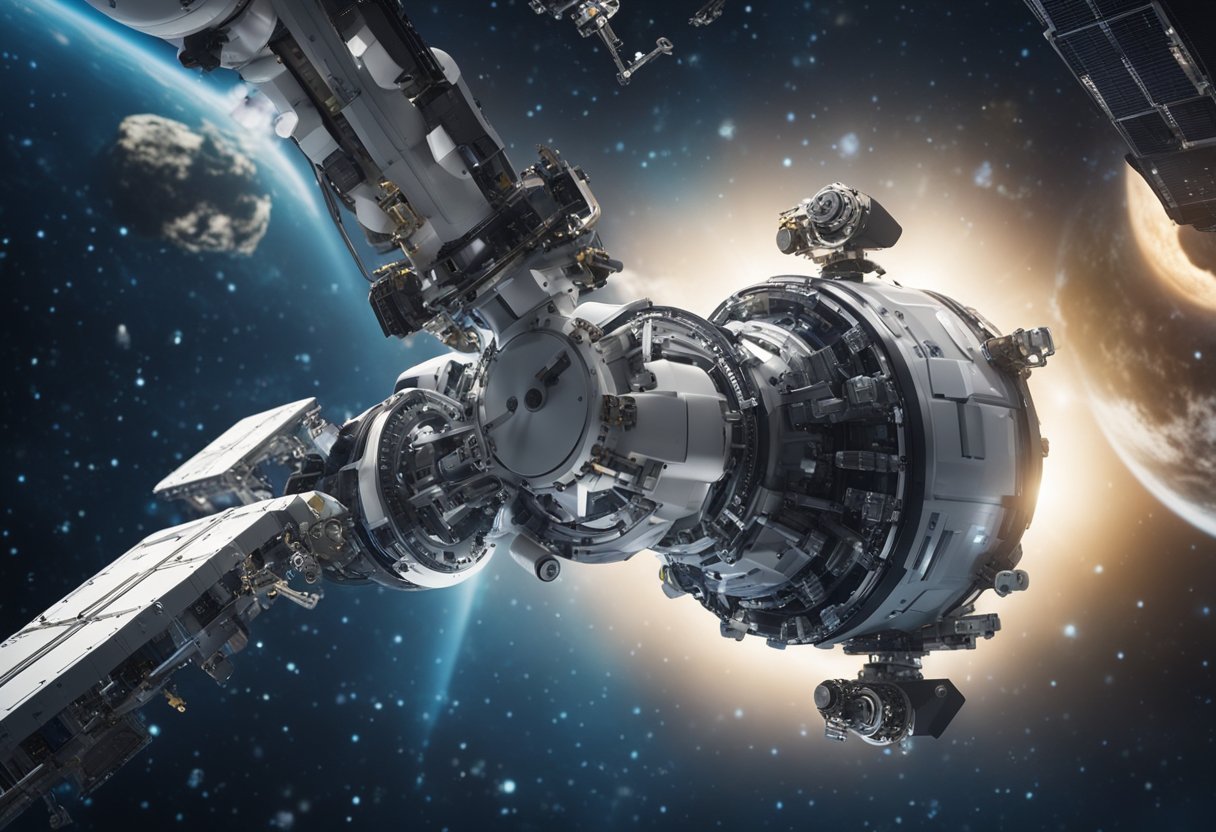
Over the years, our understanding and application of space robotics have grown immensely. These robotic arms are not only pivotal in the construction and upkeep of the International Space Station (ISS) but also in advancing scientific experiments in zero-gravity conditions. As we push the boundaries of space exploration, robotic arms have become indispensable for deploying satellites, repairing spacecraft in orbit, and even collecting samples from other celestial bodies. Our reliance on these sophisticated systems underlines their importance in ongoing and future missions, including the potential for space tourism as highlighted by resources such as SpaceVoyageVentures.com.
In this section, we explore the critical developments in the journey of space robotics, from the deployment of the iconic Canadarm to the extraordinary scientific contributions of Mars rovers.
The Canadarm, or the Shuttle Remote Manipulator System (SRMS), marked a significant milestone in the utilisation of robotics in space when it was first used on the Space Shuttle in 1981. Developed by the Canadian Space Agency (CSA) for NASA, this robotic arm played a crucial role in deploying, manoeuvring, and retrieving payloads in space. Its design and functions paved the way for more advanced robotics in space exploration.
The Canadarm’s legacy was carried forward by Canadarm2, a more sophisticated and larger version, which was launched to the International Space Station (ISS) in 2001. This enhanced robotic arm was a leap forward in technology and functionality. It has been instrumental in the ISS’s construction, maintenance, and serves as a steadfast assistant for astronauts during spacewalks. Canadarm2 is vital for the handling of cargo and the docking of spacecraft visiting the station.
Mars rovers, like NASA’s Spirit, Opportunity, and Curiosity, have been quintessential in our quest to understand the Red Planet. These rovers have revolutionised our knowledge of Mars by conducting various experiments and sending back in-depth analyses of the Martian surface. The sophisticated onboard laboratories and robotic arms of rovers, such as Curiosity, have allowed us to conduct detailed geological and chemical surveys from millions of kilometres away.
The successes of these Mars rovers demonstrate the extraordinary capabilities of space robotics in aiding interplanetary exploration. They’ve uncovered evidence of water on Mars and provided insights into the planet’s history, climate, and geology. These achievements are not only milestones in space robotics but also stepping stones towards future manned missions to Mars.
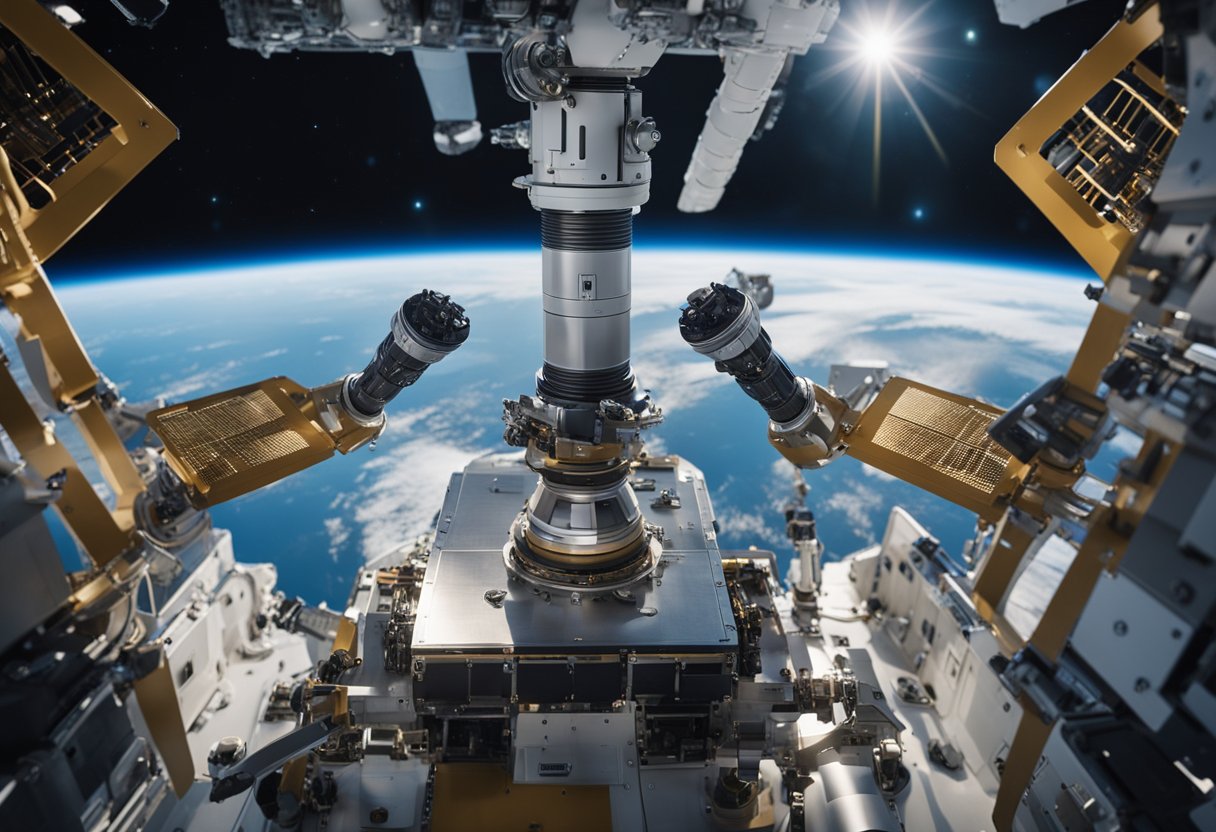
Within the realm of space exploration, robust design and engineering of robotic arms are critical. These arms must withstand the harsh environment of space and perform complex tasks with high precision.
We prioritise using composite materials like carbon fibre to construct components of robotic arms for space applications due to their high strength-to-weight ratio. Fabrication technologies such as laser cutting and waterjet cutting are employed to shape aluminium and other metals with precision. These methods allow us to create parts that are both lightweight and durable, essential for maintaining the efficacy of the robotic arms in the vacuum of space.
The degrees of freedom (DOF) in a space robotic arm determine its capacity to move and manipulate objects. A higher DOF count typically equates to greater versatility. Our engineering team ensures that each joint of the arm proficiently achieves the desired movement, from simple rotation to complex tasks, by incorporating multiple axes of motion.
Our control systems are engineered to facilitate precise operations of the robotic arm in a spatial vacuum. Advanced sensing technology is integrated to provide real-time feedback on the arm’s position and movement, ensuring operational accuracy. The system’s software takes into account the unique challenges of zero-gravity environments, programming the arm to respond with meticulous control.
When we discuss space robotics technology, we talk about the epitome of human ingenuity and adaptability – a field that embodies precision, durability, and advanced computational capabilities that are vital for the exploration of the cosmos.
The robustness and reliability of space robotics are paramount, as these machines are responsible for operations in environments where maintenance or repair is often not possible. The technology must withstand extreme temperatures, radiation, and the vacuum of space without fail. For instance, the robotic arms employed in the International Space Station (ISS) are a testament to this robust design, as they facilitate complex tasks such as satellite servicing and cargo handling with remarkable efficiency and reliability.
The kinematic analysis and understanding of dynamics are crucial in the development of robotic arms. The Denavit-Hartenberg method is widely utilised for modelling robotic joint parameters to accurately describe their motion. This modelling ensures the arm’s movements are both precise and energy-efficient, a necessity in an environment where resources are limited. By employing inverse kinematics, robots in space can calculate the necessary joint angles to achieve desired positions, crucial for the manipulation of objects in space.
Advanced control algorithms are the cornerstone of achieving effective autonomy in space robotics. Autonomy is vital, due to the delayed communication times between Earth and space machines. For enhanced precision and adaptability, robotics utilise sophisticated motion control systems. These systems allow for adjustments in real-time to the robot’s actions, a capability that is essential for the success of missions such as asteroid capture or on-orbit repairs.
Our commitment to advancing space robotics technology is unwavering, as we recognise its potential to not only advance space exploration but also to inspire future generations who may one day visit space through companies like SpaceVoyageVentures.com. The synergies between space robotics and the nascent space tourism industry cannot be overstated, with robotic technology playing a key role in ensuring the safety and success of civilian space travel.
Robotic arms play a pivotal role in our endeavours to reach beyond our planet, enabling intricate procedures in the harsh environment of space.
On-orbit servicing has transformed our approach to maintaining and extending the life of satellites. Instead of decommissioning an asset, robotic systems are used to refuel, repair, or upgrade satellites, thereby enhancing their functionality and longevity. This advancement allows us to more effectively manage our orbital infrastructure.
Robotic arms ar critical for the effective management of on-orbit servicing missions. These highly dexterous systems are capable of tasks that would be risky or impossible for astronauts to perform, such as handling delicate components or working in hazardous areas where human presence is not advised.
Robotic explorers have become our standard bearers on other planets, particularly on Mars, where the rovers have provided invaluable data about the Martian terrain and geology. These rovers, armed with scientific instruments, extend our reach and understanding of other worlds.
The integration of robotic arms into Mars rovers like the past missions of Opportunity and Curiosity, and now Perseverance, allows us to conduct detailed scientific work. Equipped with cameras, drills, and other instruments, these arms gather soil samples and enable close-up examination, significantly advancing our knowledge of Mars.
Robotic systems, and specifically robotic arms, are continuously proving to be essential in our conquest of space. The technology allows us to venture further and execute missions that were once thought to be the stuff of science fiction. With every successful repair and planetary probe, we pave the way for more complex operations, including the prospects detailed on SpaceVoyageVentures.com, which showcases potential future exploits in space tourism.
Robotic arms are essential for the success of on-orbit operations at the International Space Station (ISS). They enable both maintenance and construction activities, as well as the intricate handling of payloads to support ongoing research and the station’s operational needs.
We rely on sophisticated robotic arms like the European Robotic Arm, which is capable of ‘walking’ around the Russian segment of the ISS, to perform a variety of maintenance tasks. This advanced piece of machinery helps with the installation of new equipment, repairs, and the general upkeep required to keep the ISS fully operational. The European Robotic Arm is a prime example of such technology in action.
The remote manipulator system, commonly known as Canadarm2, is another critical component that contributes to the station’s maintenance. It can move to different parts of the station to carry out construction tasks or supply aid in extravehicular activities, thereby supporting the continuous development of the ISS infrastructure.
For the management of payloads, the capabilities of robotic arms are unmatched. They possess the dexterity and precision required to handle various payload capacities safely and efficiently. In fact, Canadarm2 and the Japanese Experiment Module Remote Manipulator System are frequently engaged in the berthing of visiting vehicles and in manoeuvring external payloads across American and Japanese modules of the station. These tasks are vital to ensure that the station is resupplied with essentials, as well as experimental apparatuses.
Moreover, the role of these robotic arms extends beyond just movement and positioning. They are involved in safely releasing spacecrafts like the Cygnus from the ISS after they have completed their missions, emphasising their importance in the full cycle of payload handling – from arrival to departure.
Robotic arms, such as Dextre, also enhance our payload handling capabilities by conducting delicate operations and tool handling, which are pivotal in the day-to-day maintenance and versatility of the ISS.
Robotic arms have revolutionised the way we perform scientific tasks in space. These manipulators allow us to conduct experiments with precision under the unique conditions of microgravity.
Microgravity significantly affects physical and biological systems. It allows us to observe phenomena impossible to replicate on Earth. Our robotic manipulators, equipped with a multitude of instruments, are crucial for handling delicate experiments in this environment. For instance, we utilise these arms to cultivate crystalline structures that require the absence of sedimentation to form flawlessly.
Complex structural analysis of spacecraft is essential in predicting and mitigating structural vibrations. Through simulation software and the precision of our robotic arms, we meticulously examine these vibrations to ensure the spacecraft’s integrity. Such analysis is paramount, particularly when attaching modules or conducting repairs, where even minor vibrations can have substantial effects.
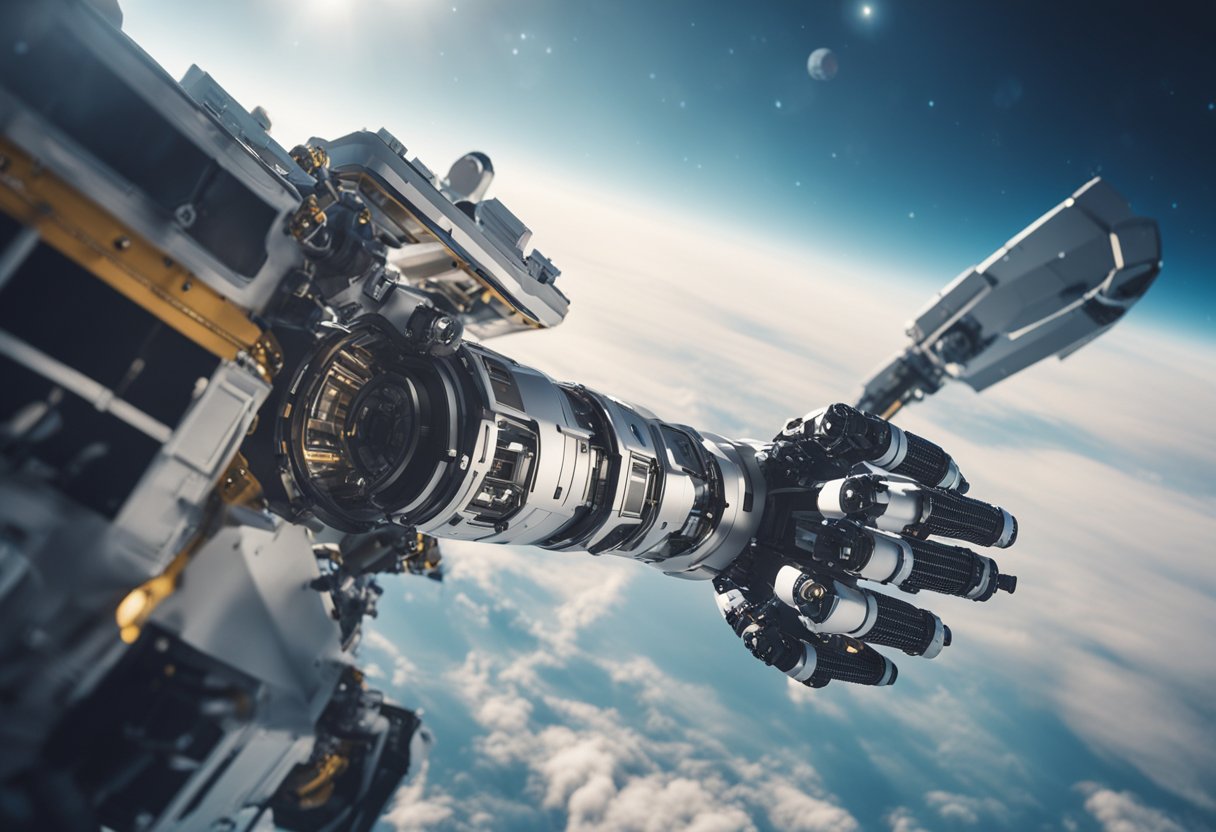
In space robotics, we face unique obstacles that demand innovative solutions. Robots operating in space must exhibit resilience and adaptability in an environment known for its harshness and unpredictability.
Space debris, also known as orbital debris, presents a significant hazard to robotic operations in orbit. We must consider both active and passive space debris removal strategies. Active removal entails deploying robots capable of capturing and redirecting debris, whereas passive methods incorporate design considerations that minimise the chances of collision. The essence of this challenge is not just the volume of debris but also the high velocities at which they travel, turning even small fragments into potential projectiles capable of severe damage.
The application of nonlinear control is crucial in space robotics to handle the erratic and often unpredictable behaviour of robotic arms in microgravity environments. We strive for precision in movement despite these nonlinearities, ensuring the robotic arm can interact with objects securely and effectively. Contact dynamics pose an additional layer of complexity, as it involves the physical interactions between the robotic arm and other objects, which can be highly variable due to the lack of a stable environment. Achieving reliable control in these circumstances is key to the success of space missions.
We already see efforts to address these challenges in advanced systems and research. For instance, in the removal of space debris, designed systems must operate autonomously with minimal human input due to the significant time delays in communication between Earth and the robotic systems in orbit. Ensuring that the robots can make real-time adjustments to their plans is vital for the safe and effective removal of debris.
When looking forward to our exploration and use of space, including ventures like SpaceVoyageVentures.com, which documents the frontier of space tourism, it is clear that overcoming the challenges in space robotics is not just about scientific progress but also about sustaining the safety and viability of future space activities.
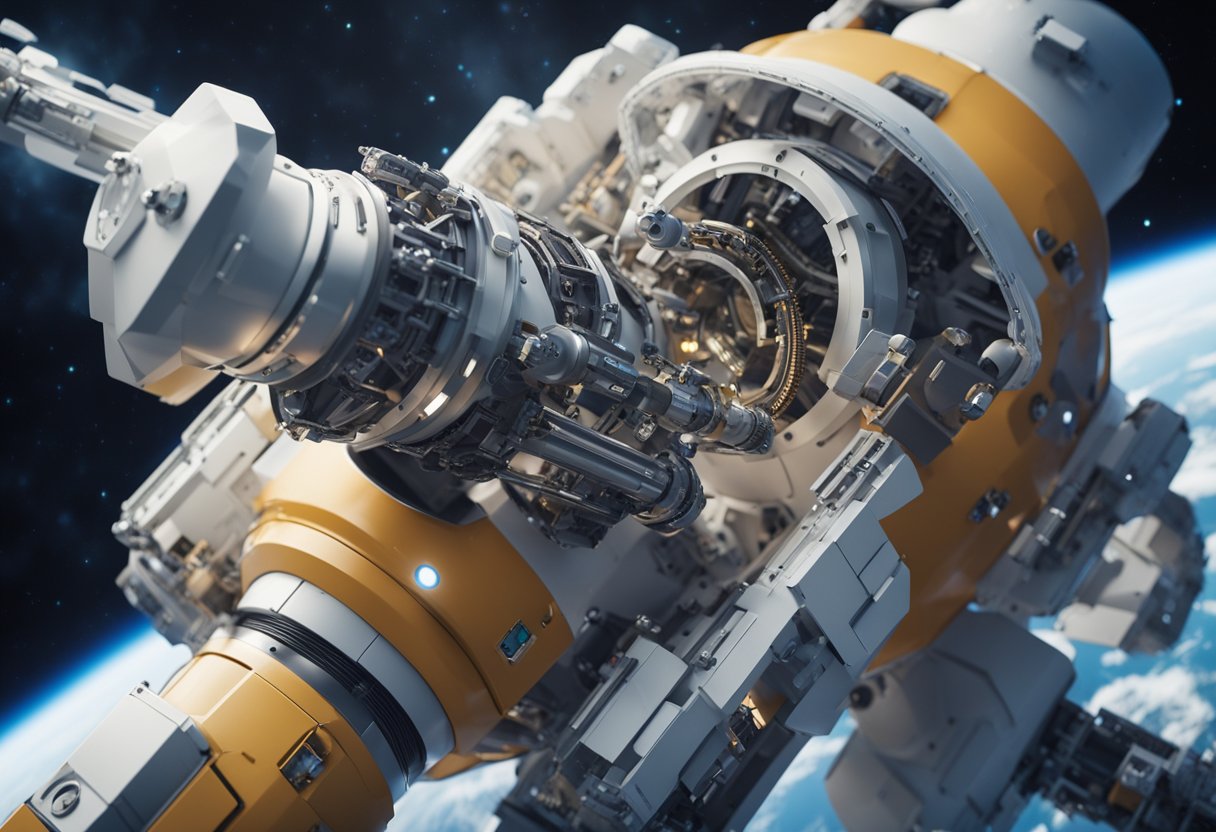
We are witnessing a remarkable evolution in the domain of robotic arms, particularly in their mechanisms and actuation systems. These advancements elevate the efficiencies of space missions and extend the capabilities of exploration.
End effectors, the “hands” of robotic arms, have undergone significant transformation to enhance their functionality and versatility. We have seen the integration of modular robots that allow for a swift interchange of tools depending on the task at hand. Advanced end effectors are now often embedded with self-healing capability, enabling them to recover from minor damages incurred during operations. This feature is particularly crucial in the harsh environment of space.
The actuation systems that control the movement and positioning of robotic arms have also experienced substantial innovation. The incorporation of mechatronics has provided a synergy between electronic control systems and mechanical systems to create more responsive and precise actuation. Soft robots, utilising flexible materials, offer exceptional adaptability and safety when operating alongside human astronauts.
We are now using 6 degrees of freedom (DOF) manipulators, which allow for complex movement in space, including rotation and articulation. These systems often employ worm gears and planetary reduction gears, favoured for their precision and reliability. Additionally, DC motors serve as a backbone for these systems, offering durability and efficiency.
In our exploration of space, these innovations in mechanisms and actuation pave the way for more ambitious and intricate missions. Robotic arms equipped with flexible end effectors and advanced actuation systems extend our abilities and signify an exciting era of space operability.
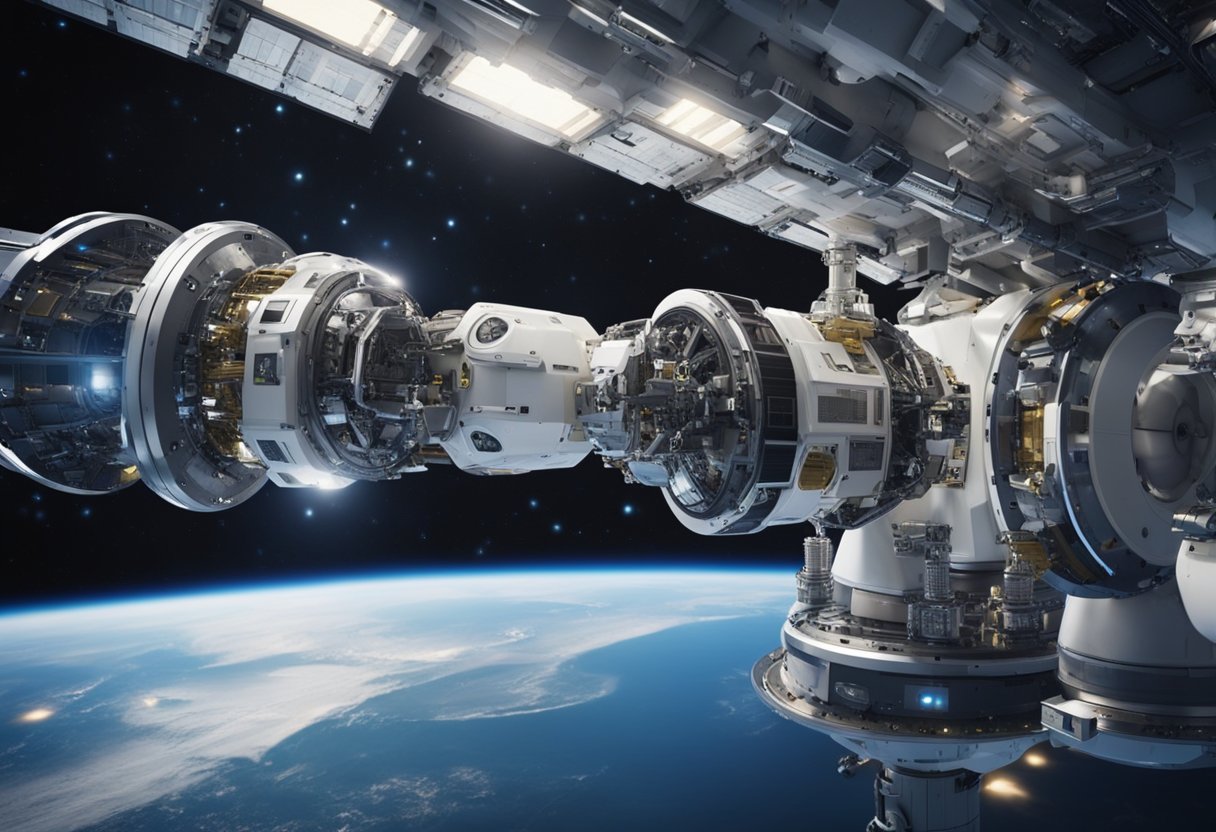
In the progression of space exploration, robot autonomy is the key enabler for advanced operations and efficient task management beyond Earth. We observe a shift from direct human control to robotics that can make decisions and execute tasks independently.
Initially, tele-operated haptic arms have been essential in facilitating human control over robotic systems in space. They allowed us to perform intricate tasks remotely, replicating a human’s touch and feel. As we move forward, the technology evolves towards autonomous capture, where robotic arms independently engage with satellites or other objects in space, harnessing sophisticated control schemes and mechanical structures.
Unmanned ground vehicles rely heavily on autonomous systems to navigate and operate in the harsh space environment. Over time, we are enhancing their capabilities, allowing them to traverse varied terrains and conduct scientific research without direct human intervention. The autonomy of these systems is paramount in missions where the time lag in communication to Earth makes immediate human input impractical.
In this transition, we are setting the stage for a future where unmanned explorers can build habitats, mine resources, and support the burgeoning field of space tourism as outlined by ventures like SpaceVoyageVentures.com.
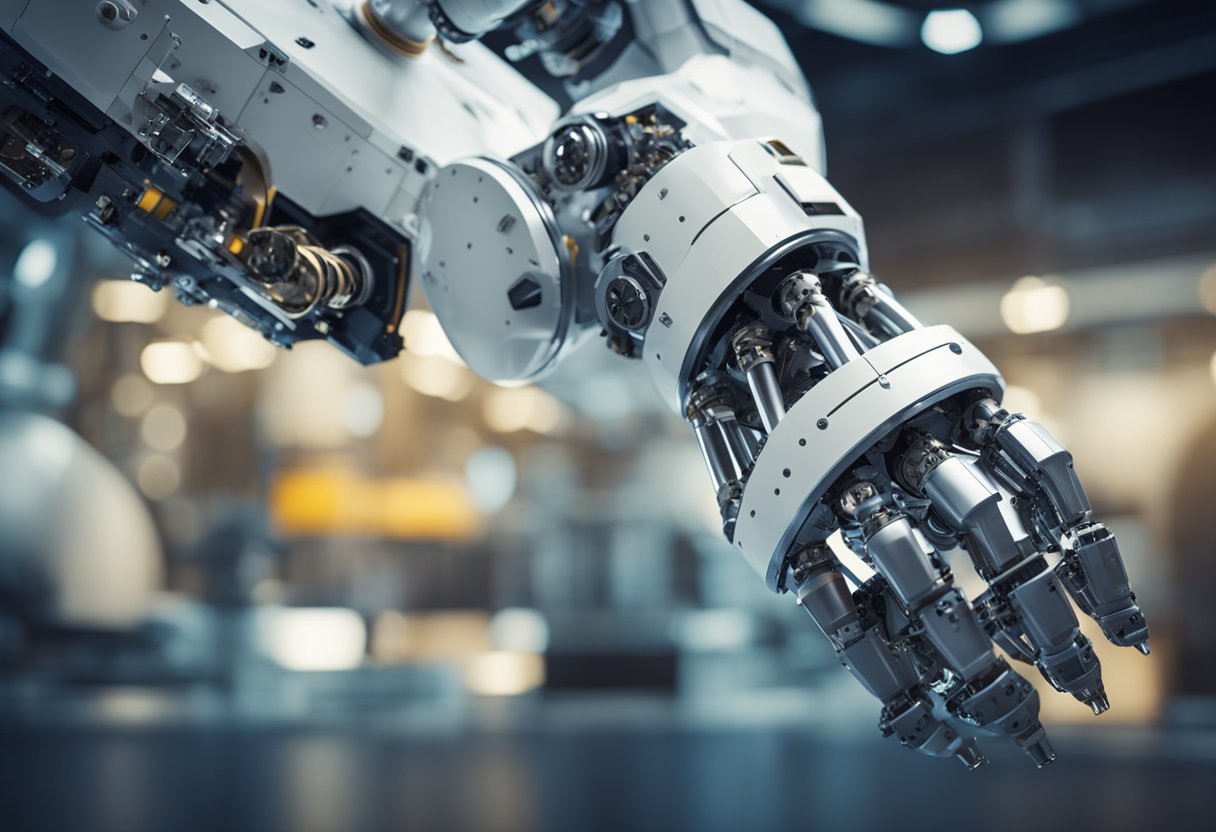
In the development of robotic arms for space applications, selecting the right materials and an innovative structural design is paramount. We focus on materials that combine strength with lightness and designs that offer significant adaptability and an extensive working envelope.
Composite materials, particularly those reinforced with carbon fibre, are revolutionising the construction of robotic arms in space. The carbon fibre shaft provides an exceptional strength-to-weight ratio, which is crucial for reducing launch costs and improving the arm’s payload capacity. We meticulously integrate composite materials into robotic arms to withstand the extreme conditions of space while maintaining structural integrity.
Our design philosophy emphasises adaptability and an extensive range of motion. A robotic arm must be capable of performing a diverse array of tasks within its working envelope, from the assembly of space structures to the repair of satellites. This demands a design that allows for a high degree of freedom and precise control. Utilising advanced software, our designs enable the robotic arm to execute complex manoeuvres, ensuring efficiency and safety in space operations.
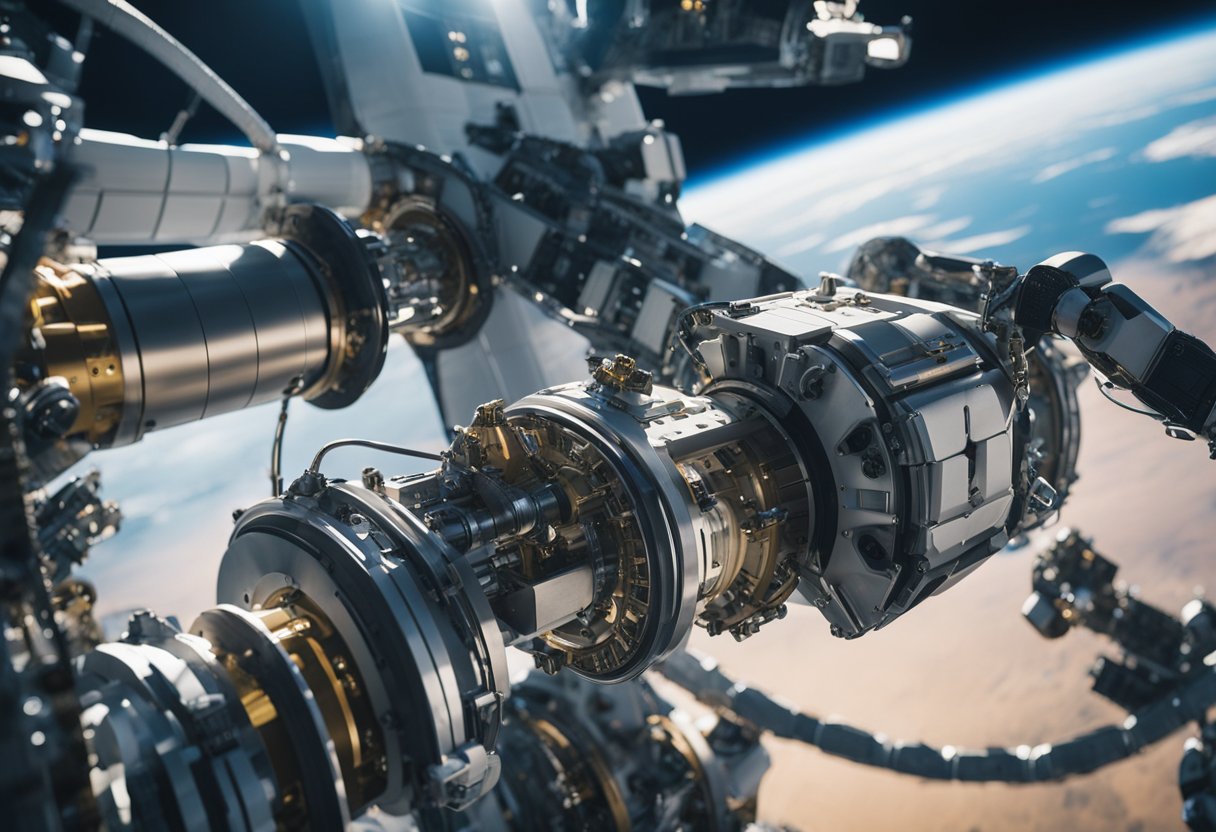
In this section, we’ll address some common inquiries regarding the use of robotic arms in space exploration, focusing on their applications on the International Space Station, in satellite servicing, and their overall impact on space technology.
Robotic arms on the International Space Station (ISS) are crucial for a variety of tasks, including manoeuvring large payloads, assisting astronauts during spacewalks, and facilitating docking procedures. The Canadarm2 on the ISS is a prime example, providing both mobility and support for extravehicular activities.
Robotic arms are instrumental in the on-orbit satellite servicing, which includes tasks like refuelling, refurbishing, and even the de-orbiting of satellites. This technology extends the life span of satellites, making space operations more sustainable.
NASA employs several robotic arm systems, such as the previously mentioned Canadarm2 and the Robotic Servicing Arm designed for more complex tasks like asteroid capture and the assembly of large space telescopes. These arms have a range of capabilities, from delicate fine motor operations to the handling of massive modules.
Robotic arms have been pivotal in the assembly and maintenance of space structures, like the ISS. Their ability to precisely position components and perform construction tasks in the vacuum of space has been fundamental to building the ISS, as well as other orbital infrastructures.
The European Robotic Arm (ERA), with its advanced automation features, can transfer and install payloads, support science experiments, and maintain station hardware. It operates through a series of pre-programmed tasks as well as manual control by astronauts, demonstrating versatility and high levels of dexterity.
Utilising robotic arms has led to significant advancements in space exploration, such as the capacity to build intricate structures in orbit and perform detailed repair work, all while avoiding the risks associated with human extravehicular activities. The contribution of robotic arms to space robotics is allowing us to push the boundaries of what’s possible beyond Earth’s atmosphere.